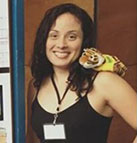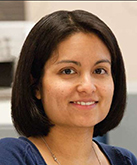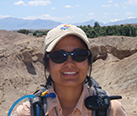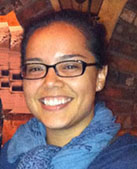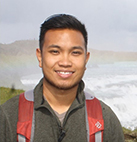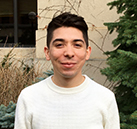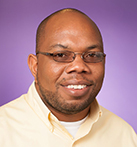AGI Announces Recipients of DCO Diversity Awards
As part of a 2-year initiative supported by the Alfred P. Sloan Foundation, AGI has awareded fourteen traditionally underrepresented geoscientists grants to advance their research and collaborate with the Deep Carbon Observatory. AGI would like to recognize and congratulate these individuals for their impressive proposals and research.
Elizabeth Padilla, PhD recipient, University of Tennessee, Knoxville
"Currently, I am an adjunct Professor at the Inter American University of Puerto Rico. This last fall, I taught courses in General Biology, Microbial Ecology and General Microbiology. During my Ph.D. training as an environmental microbiologist, I did a lot of “bench work,” especially using molecular biology techniques. I rarely got the chance to go out to the field and collect the samples myself. Imagine my excitement [during the DCO Early Career Scientist Workshop at the University of the Azores] of being able to take samples from hydrothermal environments, such as fumaroles at the steps of a volcano, on a magnificent island in the middle of the Atlantic. I was stunned."
Celina Suarez, Assistant Professor, University of Arkansas
“My research aims to characterize the occurrence of large scale fluxes of carbon into the atmosphere by identifying the hallmark of rift eruptions, a large negative carbon isotope excursion in the rock and fossil record and associating it with the occurrence of extinction on land. This study to some extent is an experiment that tests what can happen given large-scale carbon flux into the atmosphere.”
Marina Suarez, Assistant Professor, University of Texas San Antonio
“The deep carbon reservoir is linked to Earth's surface through volcanic activity which has varied in the past. In the Cretaceous Period, high volcanic activity was linked to global warmth. I'm interested in how this affected the continental environments. The continental record is important because it is intimately tied to the Earth system as a source for nutrient input to the oceans.”
Jeremy Williams, Assistant Professor, Kent State University
“My research focuses on reconstructing the paleo-environment of black shale areas through geochemical proxies, to better understand the mechanisms needed to create hydrocarbon resources. By reconstructing these environments we will better understand the source of hydrocarbon resources that may lead to better practices in exploiting this natural resource.”
Yadira Ibarra, Postdoctoral Fellow, Stanford University
“I study mineral springs in the coastal western United States. These springs, which are primarily made of limestone, can help us learn more about changes in climate and water over the past tens of thousands of years. Active springs are especially interesting as they serve as natural laboratories to investigate how living things, such as plants and microorganisms, interact with the rock.”
John Paul Balmonte, PhD candidate, University of North Carolina Chapel Hill
“I investigate the carbon processing capabilities and community composition/diversity of surface and subsurface water and benthic microbes using geochemical and genomic approaches. This information will help us understand how the climate-induced acceleration in glacial melting and subsequent increase in carbon export could change the structure and function of microbial communities in fjords.”
Matthew Medina, PhD candidate, University of Michigan
“I study microbial communities that live in The Middle Island Sinkhole (MIS) of Lake Huron. The MIS hosts microbial mats that thrive under low-oxygen, sulfidic conditions and thus represent a modern analogue of Precambrian microbial mats ecosystems. I’m interested the biogeochemistry of the MIS and the metabolisms of sulfate reducing bacteria found both in microbial mats and sediment.”
Daniel Colman, Postdoctoral Researcher, Montana State University
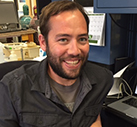
"The deep hot subsurface biosphere represents an area of particular intrigue for individuals interested in the origin and evolution of life, the extent of subsurface biogeochemical cycling, and the possibility of subsurface life on other planets. In [my] work, geochemical signatures of deep-subsurface sourced and near-surface sourced fluids will be coupled with microbial community analyses from the same springs to test for the presence, extent and nature of a YNP subsurface biosphere. In particular, differences in carbon cycling metabolisms (and other physiological characteristics) from subsurface-typical and surface-typical spring microbial populations will be tested to provide insight into differences between subsurface and surface microbial adaptations."
Rosa Zayas, Postdoctoral Fellow, University of Delaware

"[My] main research interest involved understanding the dynamics of microbial communities composition and functional characteristics in oceanic extreme environments, particularly continental margines and deep oceanic trenches. Using various "omics" techniques [I] look at the genetic material of individual microorganisms in the environment (genomics) or all microorganisms in a given environment (metagenomics) to infer the metabolic processes that microorganisms are capable of performing. Currently, [I] work with samples collected from the Tonga Trench, water column and sediments, at ~9100m water column depth and Costa Rica margin sediments down to 93 m below the seafloor."
Omar Harvey, Assistant Professor, Texas Christian University
"My research group combines microbiological, thermodynamic, spectroscopic and isotopic techniques to understand organic-inorganic and abiotic-biotic interactions in geologic systems. We are particularly interested in geochemical outcomes of archaea-mineral interactions in H2-limited versus H2-rich conditions, how energy and mass transfer differ in these systems and broader implications for biogeochemical cycles/cycling in CO2-enriched environments."
Pedro Marenco, Associate Professor, Bryn Mawr College
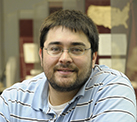
"I use geochemical approaches to investigate environmental changes associated with major paleobiologic events such as mass extinctions and biodiversification events. In particular, I have focused on the oxygenation of the oceans as a factor in these events. Seawater oxygen is tied not only to biodiversity, but it is also an important factor in the accumulation of carbon on the seafloor, which is a major reservoir for carbon on Earth."
Pablo Garcia Del Real, PhD, Stanford University
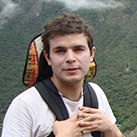
"My research focuses on determining the parameters that govern magnesium carbonate mineralization and serpentinization in a variety of geologic environments. These processes, which evidence dynamic transformations of oceanic crust lithologies, can help us understand geochemical pathways and carbon fluxes in weathering, hydrothermal and mineral ore systems, and provide constraints on CO2 sequestration in ultramafic rocks."
Moyo Ajayi, MS, Vanderbilt University

“My research investigates the exchange of greenhouse gases at the soil-atmosphere interface. Currently, I am examining methane emissions in locations where high volume hydraulic fracturing (HVHF) methods are being implemented in eastern Tennessee. I plan to determine the quantity and the location of methane emissions, and connect those findings with isotopic analysis to find the source of those emissions. The primary objective is to understand the strength of the connection between HVHF activity and the increasing concentration greenhouse gases in the atmosphere.”
Heidi Needham, MS, University of Hawaii
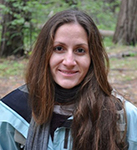
"As an early career geoscientist living in one of the most volcanically active places on Earth, I am keenly interested in gaining a comprehensive understanding of atmospheric changes from volcanic outgassing and the effect these changes have on climate from both a research and resource management point-of-view. My research involves running the MT-CLIM model to provide data where there are gaps throughout the state, including the active volcanic regions which are often affected by volcanic fog (vog)."
What is DCO?
The Deep Carbon Observatory is a global research program to transform our understanding of carbon in Earth. DCO is a community of scientists, from biologists to physicists, geoscientists to chemists, and others whose work crosses these disciplinary lines, forging a new, integrative field of deep carbon science. To complement this groundbreaking research, DCO’s infrastructure includes public engagement and education, community support, innovative data management, and novel instrumentation. For more information about the Deep Carbon Observatory, please visit: https://deepcarbon.net/. For more information on the nature and scope of DCO's research portfolio, and whether your research aligns, please refer to DCO's Midterm Scientific Report, "Carbon in Earth: Quantities, Movements, Forms and Origins."


